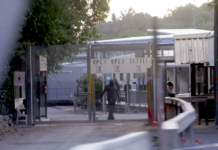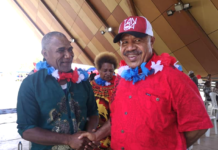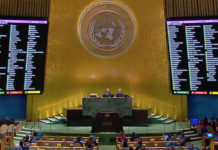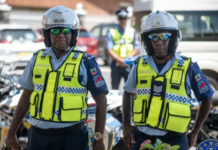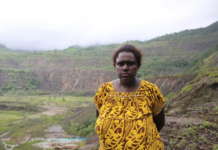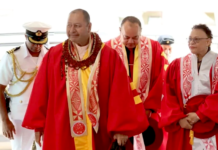
ANALYSIS: By Dr Michael Leach in Dili
Twenty-one parties will contest 65 parliamentary seats and decide who governs Timor-Leste in national elections this Saturday.
In a population with a median age of just under 19 years and a voting age of 17, a fifth of Timor-Leste’s 750,000 registered voters will be participating for the first time. This is just one of the factors making the exact composition of the new Parliament, and the complexion of the government, hard to pick.
The current government was formed in extraordinary circumstances in early 2015, when former independence movement leader and prime minister Xanana Gusmão handed the prime ministership to an opposition Fretilin figure, Rui Araújo.
Best seen as a power-sharing executive rather than a formal government of national unity, this de facto “grand coalition” between Timor-Leste’s two largest parties – the National Congress for Timorese Reconstruction (CNRT) and Fretilin – was a remarkable development. As recently as 2012, bitter tensions had existed between the two parties.
Power-sharing executives are not uncommon in the Pacific region, and generally award ministries to any parties winning a significant number of seats. They tend to facilitate political stability, but they can also reduce the accountability of government to Parliament by incorporating all significant parties into the executive government.
The fact that the smaller Partido Democrático, or PD, kept its ministries when its formal alliance with CNRT ended in 2015 suggests that this is an emerging informal feature of the East Timorese political system. Its dynamics are likely to influence the result of this month’s election.
Members will be elected under Timor-Leste’s proportional system, with voters selecting a party rather than individual candidates. Each party registers a list of 65 candidates in order of election, giving party leaders substantial power over candidates anxious to appear high on the list.
Progressive features
But the system also allows for progressive features, like the requirement that every third candidate be a woman, which has given Timor-Leste one of the highest percentages of female MPs in Asia-Pacific, at 38 percent.
The system isn’t strictly proportional. To get any of its candidates into Parliament, a party needs at least 4 percent of the vote, up from 3 percent in 2012, which effectively awards a bonus to parties that clear the hurdle.
The 4 percent might be a substantial barrier, but the large number of parties participating in the election attests to the relative ease of party registration and political participation. This feature reflects Timor-Leste’s relatively open society and pluralist culture, which saw it ranked as the most democratic country in Southeast Asia in The Economist’s 2016 Democracy Index.
The March election to the presidency of Fretilin’s Francisco “Lú-Olo” Guterres appeared to solidify the de facto accord between the major parties, with Gusmão’s endorsement helping Guterres draw some 60 percent of the national vote. The figure suggests that voters like the power-sharing arrangement between CNRT and Fretilin, which could continue beyond this election, though not necessarily in the same form.
Seeking to challenge the major parties, immediate past president Taur Matan Ruak and his new Partidu Libertasaun Popular (Popular Liberation Party – PLP) have focused on basic health and education spending rather than the megaproject-led development favoured by the government.
The PLP vocally opposes the unpopular life pensions for politicians, and has also raised allegations of patrimonialism and the growth of “money politics” in awarding government contracts.
While these issues have the clear potential to resonate in the electorate, the present government’s success in maintaining political stability and reducing political conflict within Timor-Leste’s political elite remains a major electoral asset.
History of conflict
In a country with a long history of conflict and memories of the 2006–07 political crisis, this factor alone undoubtedly means that CNRT and Fretilin will remain highly competitive. Irrespective of which major party comes first, their ability to coexist will remain central to political stability in Timor-Leste.
Nevertheless, the PLP and other smaller parties will take encouragement from recent polls suggesting that far fewer people are happy with the direction of the country than three years ago, including just 50 percent of those under 25, down from 80 percent in 2014. While anti-corruption campaigns have rarely swayed votes in the way spending programmes can, alternative development visions focused on basic development indicators may resonate in communities where infrastructure spending programmes have provided few benefits to date.
The parties’ electoral campaigns have played to their respective strengths. Xanana Gusmão’s personal legitimacy and popularity as the former resistance commander remains the cornerstone of the CNRT’s appeal. Though the party also includes extremely competent and senior ministers, including minister of state Agio Pereira, the CNRT has been criticised for being little more than a political vehicle for Gusmão and entirely reliant on his charismatic legitimacy – a perception reinforced when a new PM was not chosen from within the party, and again when the party decided not to field a presidential candidate.
In fact, posters featuring the wider CNRT team of ministers were dropped in the early weeks of the parliamentary campaign in favour of images of Gusmão alone. The current party slogan, “Vote for our future,” suggests continuity with earlier CNRT campaigns focused on rapid modernisation through government-led infrastructure spending, in line with Gusmão’s Strategic Development Plan.
For its part, Fretilin’s parliamentary campaign seems the most modern and professional, reflecting its status as the most disciplined and well-established of the East Timorese parties. With the slogan “For a more developed Timor-Leste,” Fretilin’s campaign materials promise improved outcomes in education and health using images of East Timorese making a “plus” sign with crossed fingers.
Because resistance credentials remain central to political fortunes in Timor-Leste, the loss of the party’s most senior Falintil veteran, Lú-Olo, who can’t campaign actively as president, has been notable.
Fretilin’s social media campaign has been at pains to counter suggestions that the current government represents a coalition with CNRT, reiterating their view that prime minister Araújo and other ministers participate in the current government as individuals. The party says that it remains committed to working with Gusmão after the election in the interests of stability, but that formalised cooperation with the CNRT more broadly is a different proposition.
Tough decisions necessary
It is by no means clear that Fretilin would again accept ministries if it finished in second place, though it acknowledges that tough decisions may need to be made in the interests of national stability.
For the PLP, the focus on Taur Matan Ruak as leader draws on two sources of symbolic strength: his legacy as the final commander of Falintil during the resistance era, and his more immediate presidential legacy as the closest thing to a national opposition leader from 2015. Ruak attacked the government in Parliament over accountability issues in early 2016, and vetoed the initial version of its budget; his relationship with Gusmão has yet to recover from this episode.
Supported by a host of younger Western-educated East Timorese from Dili’s intelligentsia, the PLP campaign represents a transitional point between an older mode of resistance legitimacy and generational change. Campaign rallies have focused on opposing discrimination, criticising the vast expenditure on “megaprojects,” and urging the greater focus on basic health, education and agriculture spending frequently recommended by Dili’s civil society organisations.
Reflecting its position at 12th place on the national ballot, the PLP has talked of using “Vitamin 12” to combat corruption. More controversially, it backs obligatory military service, though it argues this is best seen as a nation-building programme of public works projects and employment creation.
Unlike the large setpiece rallies of CNRT and Fretilin, which see supporters (known as “militants”) trucked in from elsewhere in the district, the PLP has focused on smaller rallies at the posto, or subdistrict, level. The smaller scale reflects its smaller budget, and the idea that it is running a grassroots campaign.
At rallies, the party points out that millions have been spent on the south-coast Tasi Mane petroleum project while the locals still have poor educational and health outcomes, and that – despite the brand new south-coast highway – the more important road from the southern town of Suai to Dili remains poor.
The PLP also campaigns against the new “unelected leaders” of the exclave of Oecusse – a clear dig at Fretilin’s leadership of the Special Social Market Economy Zone project in the Oecusse district, known as ZEESM.
Ruak has been joined onstage at rallies by some important characters, including well-known Falintil veteran “L4” and one of Fretilin’s early leaders, Abílio Araújo, who was later expelled from the party.
Different implications
PLP sources privately estimate winning between 10 and 20 seats, though local political commentators assess the likely range more modestly at between five and 15. Either way, these low and high estimates have very different implications. At the low end, the PLP would at least represent a welcome reinvigoration of parliamentary opposition. At the upper end, it would become a potential coalition partner.
Many have written off the PD, the CNRT’s former alliance partner, but what little polling exists in Timor suggests its support is alive and well – if somewhat diminished by the untimely death of leader Fernando “Lasama” De Araújo in 2015, and by the rise of the PLP, which draws on some of the same clandestine youth resistance networks and associated imagery.
The PD’s profile was boosted by the surprisingly sound performance of António da Conceição in the presidential campaign in March, in which he received the backing of the PLP. By contrast, the fourth party in the current parliament, Frente Mudansa, appears to be in considerable trouble after one of its key figures, Jorge Teme from the exclave of Oecusse, threw his lot in with the PLP.
With an outright majority for any one party unlikely, and in the absence of reliable polling, local commentators have been looking for reasons why the major-party vote shares from 2012 (CNRT 36 percent, Fretilin 30 percent) might change in 2017. Some point to growing popular dissatisfaction with the direction of the country, arguing that it opens space for the PLP to gain seats.
But it is also possible that new entrants like the PLP will take votes from smaller parties, which together received 20 percent in 2012, and were excluded by the hurdle requirements. Others argue that the political value of stability will prevail, and that there is a real chance of a “business as usual” result.
Reinforcing this sense, the election campaign has been very sedate, and even dull, with the most interesting question being how well the PLP can perform.
For Fretilin, positive comments by José Ramos-Horta about the role of Mari Alkatiri and Lú-Olo in stabilising East Timorese democracy in recent years have been welcomed by the party and highlighted in social media. More recently, Ramos-Horta has made the same comments about Gusmão, and has also encouraged Ruak to reconcile with him.
Fretilin’s stewardship
At the district level, the impact of Fretilin’s stewardship of the ZEESM project will be interesting to watch in Oecusse, as will the CNRT vote in the district of Covalima, where the massive Tasi Mane project is closely associated with Gusmão’s party.
It is too early to say whether the “build it and they will come” approach to attracting private investment has been successful. Certainly, the rapid development of new infrastructure has resulted in some high-quality bridges and roads, but it has also created resentment and displacement in local communities governed by older customary land use practices. These two district votes will therefore offer an interesting mini-analysis of the local reception of ambitious development plans.
Overall, the key question for July 22 is whether the CNRT and Fretilin can withstand the challenge from the former president’s PLP, and what sort of reconstituted cross-party government would follow. While the March presidential poll suggested a welcome reinvigoration of parliamentary opposition, it also raised the real possibility of a “business as usual” outcome in the parliamentary elections, at least in terms of seats.
The nature of any arrangement between the major parties may, however, change considerably. Meanwhile, the PLP and other parties have had another four months to campaign widely and expand their national vote. Sources inside the PLP expect to do well in Ruak’s home district of Baucau, where the personal vote is strong, in the populous Western town of Maliana, and in Oecusse.
With a new Fretilin president already installed, a key question will be the identity of a new prime minister in the event that CNRT and Fretilin return to some form of power-sharing arrangement. While it seems likely that a new PM would come from CNRT, no one in Dili seems sure who this might be.
Obvious candidates include Agio Pereira and state administration and justice minister Dionísio Babo-Soares. Certainly, it seems clear that Gusmão himself no longer desires the role, happy to direct the government from the Ministry of Planning and Strategic Development.
For its part – assuming it is unable to form government – the PLP will need to decide if it will accept ministries if they are on offer, and thus effectively join a power-sharing executive. Or will it act as an unfettered parliamentary opposition? The poor relations between Gusmão and Ruak suggest that ministries are not likely to be on offer immediately, though this might be somewhat more likely in the event that the biggest party is Fretilin, where relations are more cordial.
‘Hugging it out’
Either way, given the capacity of the East Timorese leadership to “hug it out” over apparently insoluble grievances, this issue may confront the PLP sometime in the life of the next government.
For East Timorese society in general, the 2017 elections represent an important transitional moment, with a full fifth of the electoral roll voting for the first time. These new voters don’t remember the Indonesian era, nor necessarily the political crisis of 2006–07.
The election has also seen the welcome rise of domestic political commentary for an international audience, written by an increasingly confident and well-informed East Timorese commentariat.
Despite these shifts, a generational transition of power from the “1975 generation” of leaders seems further away than five years ago. The last two years have seen a stronger reassertion from the older generation of leaders, including Gusmão and Alkatiri, of the need for patience among younger political leaders – a notable change in tone from the “transitional” rhetoric of 2012.
The promised transition to younger leaders at the Fretilin party congress didn’t occur, and Gusmão himself has remained firmly in control despite moving from centre stage. While the key roles of prime minister and chief justice are indeed filled by the younger generation, as the major parties point out, the 1975 generation remains the key power-holder behind the scenes.
For Australia, there appears to be little prospect of a change in direction in the foreign policy positions that unite the major East Timorese parties, including the determination to demarcate maritime boundaries between the neighbouring states. Both parties to the current Timor Sea conciliation process in The Hague privately report substantial progress in recent negotiations, though numerous difficult issues remain to be addressed.
On balance, the likelihood that Canberra will face a substantially different government in Dili after July 22 seems low.
Dr Michael Leach is professor of politics and international relations at Swinburne University of Technology, Victoria. This article is republished from Inside Story with permission of the author.


